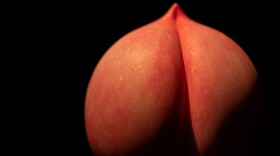A lathe spun a glass tube, and in one hand Daryl Smith held a hot torch with a burning blue flame at its tip.
Whether growing blood vessels for human transplant or looking out into the cosmos through precision telescopes, so much of what happens in science relies on glass.
Before we get into making scientific glass, a little trivia: Is glass a liquid or a solid?
"It's an amorphous solid," said Daryl Smith, a scientific glassblower at Yale University. "Now, you said it was a super-slow moving liquid -- you ever hear that story where they have the old colonial windows, and they show them thicker at the bottom? That's a myth," he said. "Glass does not flow over time."
Smith said scientists know this because they've observed a naturally-forming glass called obsidian, which is created during volcanic activity.
He said obsidian has shown no signs of flowing over time, even though it's been sitting in caverns for millions of years.
As Smith talked, he was doing some pretty amazing work. A lathe spun a glass tube, and in one hand he held a hot torch with a burning blue flame at its tip. In the other, he held a heat-resistant stick, which he used to form the glass.
Even a small leak, big enough for an electron to pass through, could compromise an experiment.
Pinched between Smith's lips was a rubber tube. It was latex and hollow, and as we talked, he constantly paused to blow into it. "Because when I heat that glass, it's going to collapse," Smith said. "So I blow into it to put pressure in there to keep it from collapsing."
As the glass spun, Smith looked directly into the flame with a pair of tinted sunglasses. At this point, he said, a lot of what he does -- controlling the flame, rotating the glass, blowing into it -- is all muscle memory.
"I tell my students, when I'm teaching, my brain doesn't know what it's doing," Smith said. "My hands have learned this."
All that glass needs to be built to last.
As we moved around the lab in the Yale chemistry building, Smith flipped on a vacuum pump and pulled out a strange-looking device: a Tesla coil, which he uses to test all the connection points and other areas of his glass to make sure there is no vacuum leak. Even a small leak, big enough for an electron to pass through, could compromise an experiment.
As we chatted, a scientist walked in with a broken graduated cylinder. It wasn't an emergency fix, but Smith said sometimes, people come to his glass shop in their darkest academic hour. They're under deadline; their glass breaks; they can't get their compound analyzed.
"They don't get their paper written; they don't get their grant money. It snowballs, so I've had them come in -- and that's why I'm here," Smith said. "That's why there are glassblowers on site so they can do those rush jobs."
"[Students] come down here, and they get mesmerized by the melting glass, and the turning."
Daryl Smith
Increasingly, scientists must design their own experiments, so Smith said it's important students in his glassblowing class understand the fundamentals of glassblowing, and how to communicate their needs to a fabricator.
For some students, glassblowing is just fun -- a tangible break from abstract theory and numbers.
"They learn a little bit about the glass, its movement -- things like that, the nomenclature -- but they often say it's very therapeutic," Smith said. "They come down here, and they get mesmerized by the melting glass, and the turning. They say that it's a relaxing effect."

Starting out, Smith said students will craft things like round bottom test tubes and hose connections. They also make glass marbles -- which they can share with their friends. Smith said there are probably only a few hundred people in the country who still do scientific glassblowing -- and there are even fewer who are stationed full time at universities.
But for those who are left, there's a common bond: working behind the scenes to make important experiments and scientific advances possible.
Ryan King contributed to this report.








